Calls to organizations monitoring UFO sightings are expected to rise over the coming weeks as the planet Mars passes close to the Earth. On June 23 the red planet will be closer to the Earth than at anytime in the past two years. And at a mere 67,578,000km away, the planet's polar ice caps will be visible to anyone with even a relatively cheap telescope.
As the planet draws closer to Earth it will appear in the sky as a bright red light hovering on the horizon. And it is this phenomenon that astronomers believe will be mistaken for unidentified flying objects by UFO spotters around the world.
The Taiwan Unidentified Flying Objects Association (TUFOA,
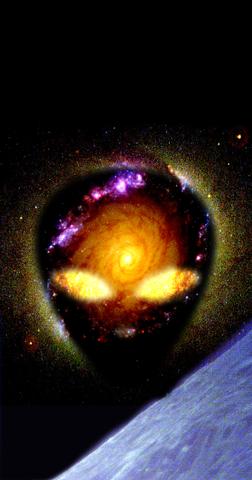
The truth is out there
Formed in 1993, TUFOA is the only organization in Taiwan researching and cataloging UFO sightings. Ho and his associates receive an average of 10 calls a year, of which two or three warrant further investigation by the organization's chief investigator, Ho Hsien-jung (
Whilst Ho's recent trip south proved a dead end -- the photo had been of Mars -- Ho says there is ample photographic evidence of UFO activity in Taiwan. Ho, along with Fox Mulder of the X-Files and a host of people around the world, is convinced that "the truth is out there."
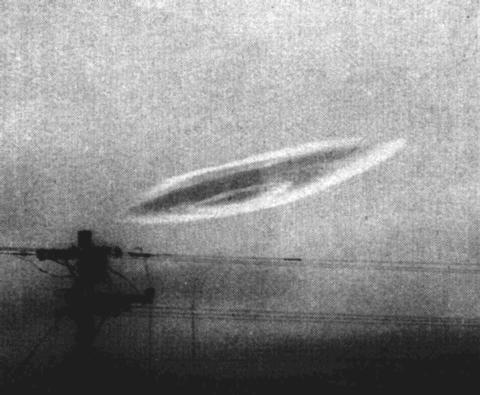
PHOTO COURTESY OF TUFOA
According to Ho there have been 15 recorded sightings where photographic evidence suggests that extraterrestrial objects have traversed the skies above Taiwan.
The earliest of these pictures was taken in Taitung City (
Wang Shi-lin (
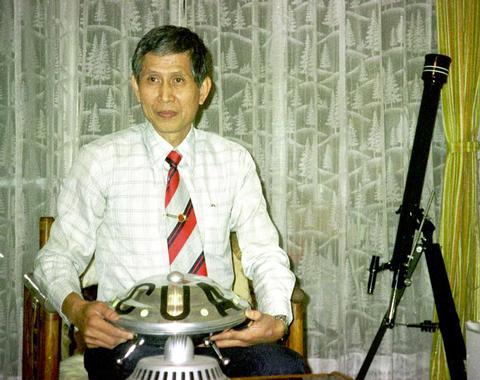
PHOTO: NY TIMES
Other photographic "evidence" ranges from the patently absurd to the almost believable.
One of the most striking UFO shots was taken at an interchange on the Sun Yat-sen freeway. Li Chun-hsiung (
In the history of the ROC, one of the earliest photographs of a UFO is one taken back in 1911 in the Chinese city of Tienjin (
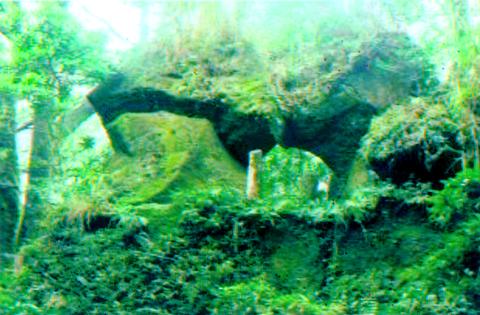
PHOTO COURTESY OF TUFOA
One shot, taken by Tsai Chang-hung (
"This photograph is the most famous photo of a UFO in Taiwan. Thousands of people have seen it and many of them believe that it is a UFO. After all Tsai Chang-hung was related to one of the nation's leading scholars, Tsai Chang-hsien.
Why would he fake a photo of a UFO? There was no point, as he certainly wasn't after fame or wealth. He came from a very respected family," explains Ho.
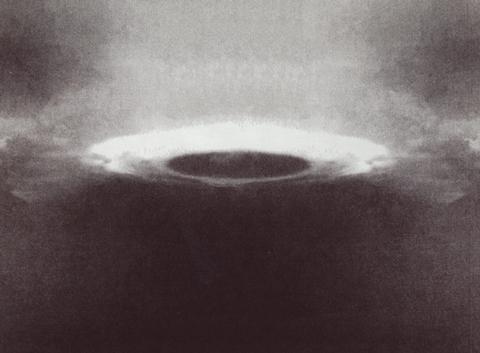
PHOTO COURTESY OF TUFOA
"The site where the photo was taken also happens to be near Yangmingshan (陽明山), where sightings of UFOs have been a common occurrences for hundreds of years."
For Ho, a location near Yangmingshan greatly increases the likelihood of sightings being the real thing. This is due to the presence on top of Chihsing Mountain(七星山) of an ancient megalith. Measuring three meters by one meter, historians have long been divided as to when and by whom this rock formation was erected. Although there is scant historical evidence as to the original use of the site, several local historians are of the opinion that the site was built by ancient peoples as a message to beings on far away planets -- a theory Ho himself believes to be true.
"There's cause to believe that megaliths in England, France, Africa and South America were all used as ways of conversing with extraterrestrial beings. A sort of `we're here' message," says Ho.
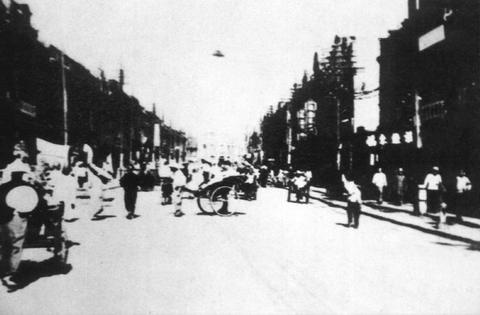
PHOTO COURTESY OF TUFOA
TUFOA is not without its critics. Many people simply refuse to believe in UFOs. Ho has spoken to several pilots, all of whom have assured Ho that they have seen strange flying objects while flying over Taiwan. But the aviation authority and the air force have both sternly informed him on more than one occasion, however, that his sources were mistaken.
Avoiding the spotlight
Warnings such as these from official sources are the reason why Ho and his investigation teams shun publicity.
"We don't like to be in the spotlight. Sure we could call a press conference every time we suspect that a sighting is genuine. And with the local press as they are, it would no doubt be well covered, but we'd end up having people simply laugh at us and thinking we're mad," explains Ho, leafing through a wallet bursting with of photographs of supposed UFOs.
"You have to understand we take all the calls seriously and follow up with investigations. Obviously if the eyewitness has photographic evidence we can ascertain very quickly what the object could be. When there are no pictures we have to seek out other eyewitnesses to corroborate the sighting. This can take a long time. Many of those involved don't particularly want attention either. They don't want their neighbors looking at them as if they're mad. So we keep all our investigations pretty quiet."
Until recently that is. Earlier this year, the organization released reports of two UFO sightings.
The first of these cases reported in the local press appeared as a brief in the United Daily Evening News (聯合晚報) on Feb. 19, 2001, and related to a supposed sighting by a retired schoolteacher, Li Sung-yi (李松宜) 14 years earlier.
At 7pm on the evening of August 25, 1987, Li was waiting on the platform at Shulin (樹林) train station, Taipei County (台北縣), when a strange light appeared from behind the nearby Tatung Mountain (大同山).
"I was waiting on the platform and this light caught my eye. At first I thought it was an airplane, but after a while the shape of the object became apparent. It was like a lemon, which is when I realized it wasn't any aircraft I was familiar with and it must be a UFO," recalls the now 74 year-old Li, recalling the incident as vividly as though it had happened only yesterday.
"The spaceship then began to fly back and forth over the summit of Tatung Mountain. By this time the lights were flashing very brightly and were hard to miss. Everyone on the platform was looking at the lights. I shouted `it's a UFO,' but I don't think anyone understood as I said UFO in English. The UFO then began gyrating incredibly quickly and disappeared just as suddenly as it had appeared. The people on the platform were all looking at each other not knowing what they'd just seen. But I knew. It was defiantly a UFO. No airplane would move in the way that object did."
Shortly after this encounter Li was invited to appear on a TV show, where he was asked to tell his story. Even though there had been a dozen or so witnesses to the events of that August night in 1987, only Li was willing to brave the media's attention.
He now wishes he had backed out, as both host and viewers found his tale incredible.
"I think the people on the show thought the whole thing was a joke," admits Li. "Which is not surprising. Before I saw that light in the sky I was skeptical about the existence of UFOs. After that, however, I changed my ideas pretty quickly."
In the weeks following Li's 1987 sighting, UFOs were reported in the skies over Taipei, Shanghai and Kyushu in Japan.
Alien artifacts
The second case to be made public long after the fact made the pages of the Liberty Times (自由時報) on 26 March, 2001. This report involved more than a UFO seen in the distance.
It was reported that 18 years ago, a student at Touchou primary school (頭州國小) in Hsinwu (新屋), Taoyuan County (桃園縣), was playing in the playground when she came across an object measuring roughly 30cm in length. The student took the object to one of her teachers. The teacher thought it to be a rubber toy and let the child take it home.
On returning home the student's brother cut open the object, and found a flesh-like substance under the outer layer. The object was clearly not made of rubber, and the children left it outside the house, thinking that if it were an alien object then other aliens would come and collect it. Nobody came, however, and after three days the object had rotted.
Ho will be the first to admit that this tale seems rather Hollywood and the lack of photographic or physical evidence makes the entire story appear bogus. The fact that there was more than one eyewitness, however, means that this is one file Ho will be keeping open, regardless of any personal doubts.
Although sightings of supposed UFOs are set to rise over the following week, the future could be a bleak one for Ho, his organization and others like it. Sightings of UFOs are at an all-time low. And according to Ho, they will continue to decrease in numbers in the future. Not that Ho is planning an early retirement.
"Sightings will become less frequent as time goes by. You only have to look at the records to see that numbers have been dropping since the 1980s. It's probably got a lot to do with the technology on Earth. The pilots of the UFOs are aware that they will be seen by somebody and possibly attacked," says Ho fervently.
"They are still out there, though, and will continue to watch us, but from a distance. As for exploration, well, I reckon extraterrestrials will continue to send spaceships to explore the universe, but they will just visit other planets and stars now. The lack of UFOs doesn't spell the end of our organization, though. Questions still need to be answered concerning all the UFO sightings that have taken place. After all, I'd like to know where the UFOs Tsai Chang-hung and all the other people have seen came from and what they wanted with Taiwan."
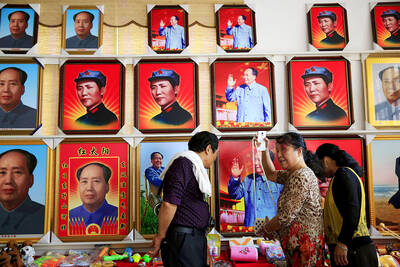
The ultimate goal of the Chinese Communist Party (CCP) is the total and overwhelming domination of everything within the sphere of what it considers China and deems as theirs. All decision-making by the CCP must be understood through that lens. Any decision made is to entrench — or ideally expand that power. They are fiercely hostile to anything that weakens or compromises their control of “China.” By design, they will stop at nothing to ensure that there is no distinction between the CCP and the Chinese nation, people, culture, civilization, religion, economy, property, military or government — they are all subsidiary

It’s always a pleasure to see something one has long advocated slowly become reality. The late August visit of a delegation to the Philippines led by Deputy Minister of Agriculture Huang Chao-ching (黃昭欽), Chair of Chinese International Economic Cooperation Association Joseph Lyu (呂桔誠) and US-Taiwan Business Council vice president, Lotta Danielsson, was yet another example of how the two nations are drawing closer together. The security threat from the People’s Republic of China (PRC), along with their complementary economies, is finally fostering growth in ties. Interestingly, officials from both sides often refer to a shared Austronesian heritage when arguing for

Nov.10 to Nov.16 As he moved a large stone that had fallen from a truck near his field, 65-year-old Lin Yuan (林淵) felt a sudden urge. He fetched his tools and began to carve. The recently retired farmer had been feeling restless after a lifetime of hard labor in Yuchi Township (魚池), Nantou County. His first piece, Stone Fairy Maiden (石仙姑), completed in 1977, was reportedly a representation of his late wife. This version of how Lin began his late-life art career is recorded in Nantou County historian Teng Hsiang-yang’s (鄧相揚) 2009 biography of him. His expressive work eventually caught the attention

Late last month the Executive Yuan approved a proposal from the Ministry of Labor to allow the hospitality industry to recruit mid-level migrant workers. The industry, surveys said, was short 6,600 laborers. In reality, it is already heavily using illegal foreign workers — foreign wives of foreign residents who cannot work, runaways and illegally moonlighting factory workers. The proposal thus merely legalizes what already exists. The government could generate a similar legal labor supply simply by legalizing moonlighting and permitting spouses of legal residents to work legally on their current visa. But after 30 years of advocating for that reform,